Could winter viruses help control the spread of SARS-CoV-2?
London School of Hygiene & Tropical Medicine https://lshtm.ac.uk/themes/custom/lshtm/images/lshtm-logo-black.png Tuesday 7 December 2021
In the UK we’re heading full pelt into the normal winter respiratory viral season, something we can all relate to: from a mild snuffle to a week in bed at the mercy of flu. As many parents will be aware, respiratory viral infections are particularly common in children who have lots of contact with others, especially at school.
Indeed, for some viruses such as flu, children have been shown to be central to transmission, inadvertently infecting parents and grandparents after contracting infections from each other. Among these annual respiratory viruses are four distinct seasonal coronaviruses that have been in regular circulation for many years. They usually cause very mild, or no symptoms, and therefore are often undetected.
Enter SARS-CoV-2, the virus that causes COVID-19. The UK has been in and out of lockdown, with schools closing and the transmission patterns of many respiratory viruses disrupted. Many people in the UK have been infected with SARS-CoV-2, with some developing severe illness and sadly dying from COVID-19. Yet children have been much less impacted. Not only do they not fall ill, they also seem to have lower infection rates compared to adults.
What causes such protection in children? One hypothesis is that recent infections with other respiratory viruses, specifically seasonal coronaviruses, may protect from SARS-CoV-2. This could be because immune responses to one coronavirus may be partially effective against other coronaviruses. As children have higher rates of infection from seasonal coronaviruses, they may be more protected against SARS-CoV-2 infection than adults.
Understanding what affects children’s susceptible to SARS-CoV-2 could help evaluate which public health policies should be implemented. For example, given we now know that children are less at risk from SARS-CoV-2, would we, with hindsight, have closed schools last year? And if there were some protection conveyed from being infected with a different virus, would that impact vaccination policies?
In our recent study, published in the Proceedings of the National Academy of Sciences, we used mathematical models to investigate whether it could be protection from seasonal coronaviruses that resulted in fewer children getting infected than expected during the first wave of the SARS-CoV-2 epidemic in England and Wales.
We found that while cross-protection from seasonal coronaviruses may have somewhat reduced the susceptibility of children to SARS-CoV-2 infection at the beginning of the pandemic, it could not fully account for it. This means there must be other factors at play in shaping the immunity of children. Could it be a difference in their immune system or could it be protection from another illness?
Finding the answers will be vital to our understanding of the role of children in this pandemic and how we protect ourselves against SARS-CoV-2 infection.
We also investigated how endemic circulation of SARS-CoV-2 could be affected in the future by the circulation of other seasonal coronaviruses. Different assumptions on the strength of cross-protection resulted in very different outcomes, with no cross-protection potentially resulting in large biennial COVID-19 outbreaks and strong cross-protection resulting in smaller but annual outbreaks.
Since this research shows that other coronaviruses are unlikely to provide strong cross protection, it reinforces the message that vaccination is crucial to our immunity to SARS-CoV-2. In this respect, I am extremely fortunate as I live in the UK where vaccinations are readily available and have had the opportunity to be vaccinated myself. This is a major contribution to my immunity, which I am very grateful for.
However, we must improve our understanding of immunity to SARS-CoV-2. Going forward, we urgently need more research on how respiratory viruses spread and which factors increase immunity to SARS-CoV-2 in different age groups.
This will provide vital evidence for future public health policies, especially those relating to subgroups of the population in which vaccination rates are lower, such as targeted information campaigns, indicating key locations for social distancing measures and designing effective testing policies.
Publication
Naomi R. Waterlow. How immunity from and interaction with seasonal coronaviruses can shape SARS-CoV-2 epidemiology. PNAS. DOI: 10.1073/pnas.2108395118
LSHTM's short courses provide opportunities to study specialised topics across a broad range of public and global health fields. From AMR to vaccines, travel medicine to clinical trials, and modelling to malaria, refresh your skills and join one of our short courses today.